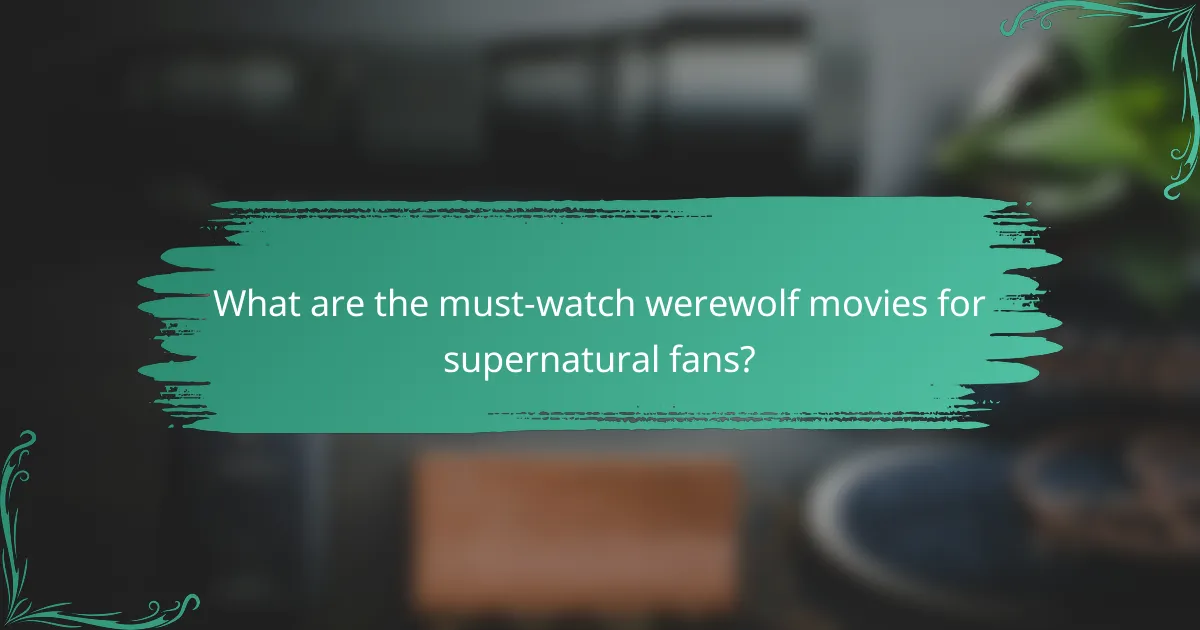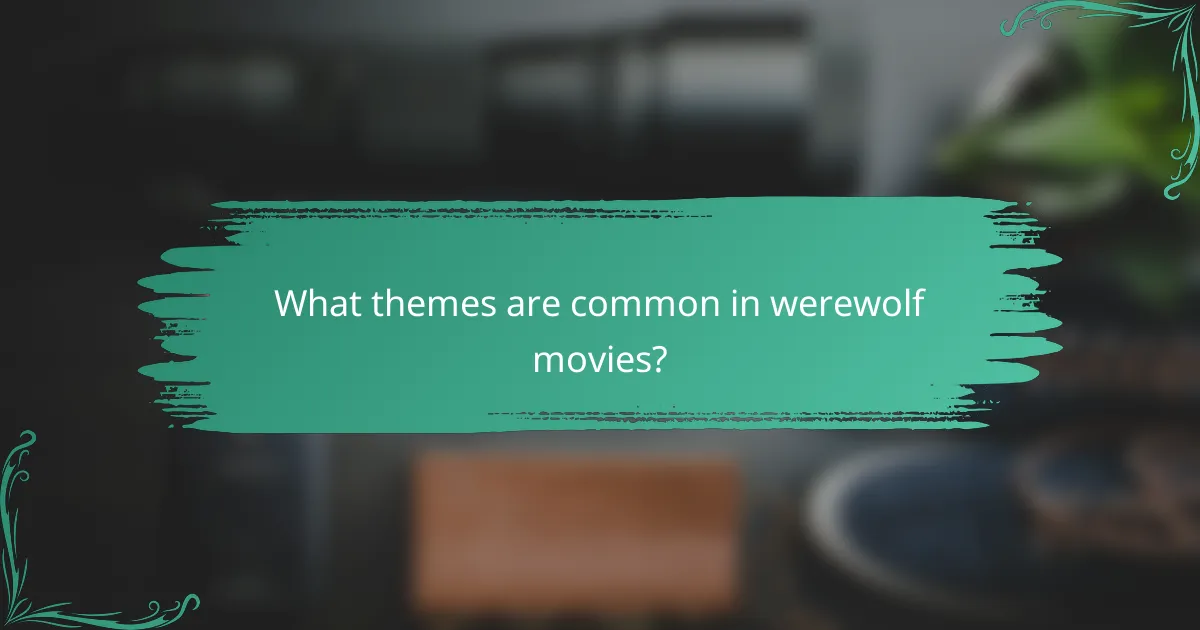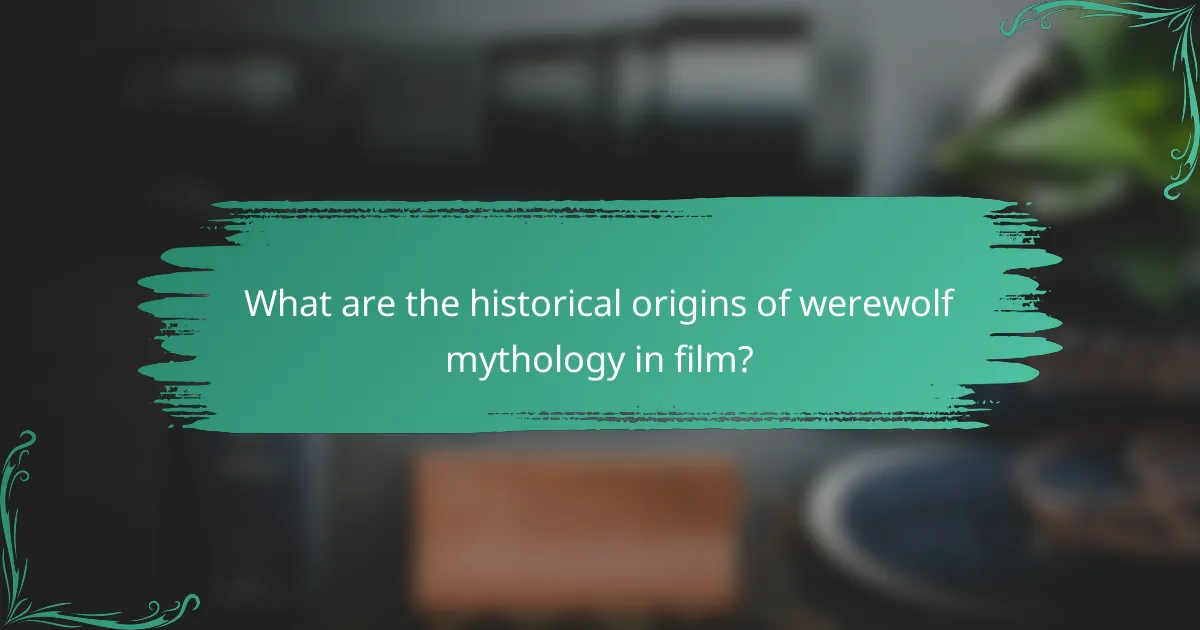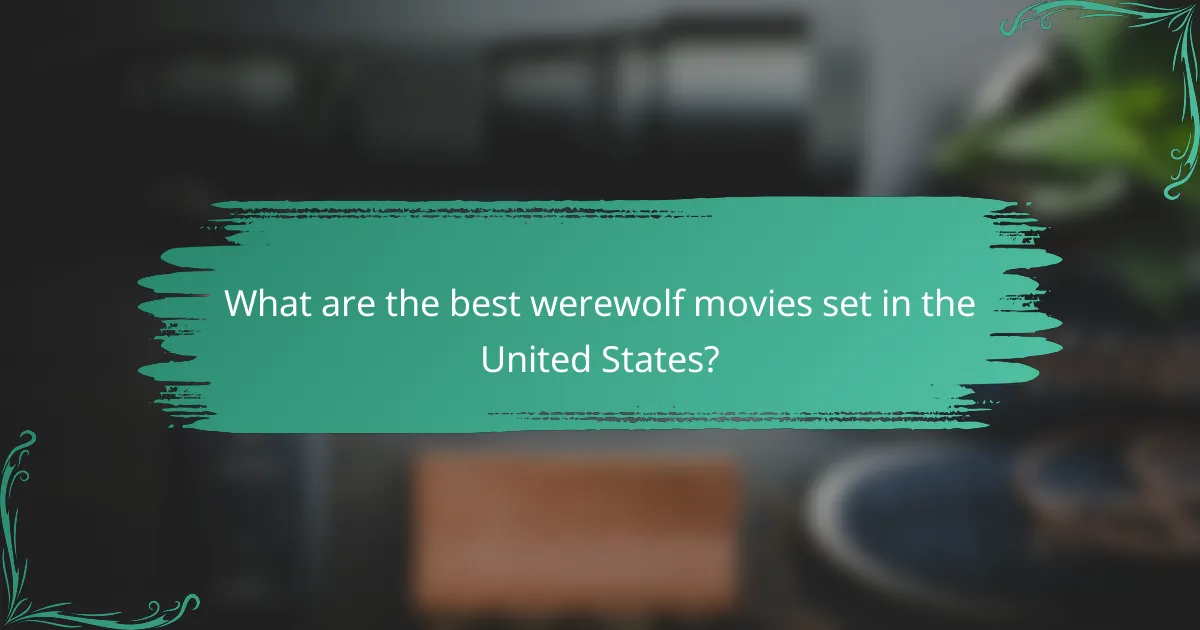For supernatural fans, werewolf movies offer a captivating blend of horror and folklore that explores the complexities of identity and primal instincts. From classic tales to modern interpretations, these films delve into the thrilling transformations and psychological struggles faced by those cursed with lycanthropy. Discover must-watch titles that not only entertain but also provoke thought about the duality of human nature.

What are the must-watch werewolf movies for supernatural fans?
Supernatural fans looking for must-watch werewolf movies should explore a mix of classic and contemporary films that capture the essence of lycanthropy. These titles not only showcase thrilling transformations but also delve into the psychological and social implications of becoming a werewolf.
American Werewolf in London
“American Werewolf in London” is a seminal film that blends horror and dark comedy, telling the story of two American tourists who encounter a werewolf while hiking in England. The film is renowned for its groundbreaking special effects, particularly the transformation scene, which remains iconic in cinema history.
Set against the backdrop of the English countryside, the film explores themes of friendship and the struggle with one’s darker nature. Its mix of humor and horror, along with a memorable soundtrack, makes it a must-see for fans of the genre.
Dog Soldiers
“Dog Soldiers” is a British horror film that combines military action with werewolf mythology. The plot follows a group of soldiers on a training exercise in the Scottish Highlands who encounter a pack of werewolves, leading to a fight for survival.
This film is notable for its intense action sequences and practical effects, creating a gritty atmosphere that enhances the horror elements. It effectively balances tension and dark humor, making it a standout in the werewolf genre.
Ginger Snaps
“Ginger Snaps” offers a unique take on werewolf lore by intertwining it with themes of adolescence and female empowerment. The story revolves around two sisters, one of whom undergoes a transformation into a werewolf after being bitten, symbolizing the struggles of growing up.
This Canadian film is praised for its strong character development and social commentary, particularly regarding puberty and the challenges faced by young women. Its blend of horror and drama resonates with audiences looking for depth in supernatural narratives.
Howl
“Howl” is a modern werewolf film that takes place on a train traveling through the English countryside. Passengers find themselves trapped and hunted by werewolves, leading to a tense and claustrophobic atmosphere.
The film is notable for its suspenseful pacing and character dynamics, as it explores themes of survival and fear. Its unique setting adds an interesting twist to the traditional werewolf narrative, making it a compelling watch for fans of the genre.
Wolfman
“Wolfman” is a remake of the classic 1941 film, featuring a star-studded cast and impressive visual effects. The story follows a man who returns to his ancestral home and becomes cursed after a werewolf attack, leading to a battle between his human and beastly sides.
This film pays homage to the original while updating the story for modern audiences. With its gothic atmosphere and exploration of familial ties, “Wolfman” is a visually striking addition to the werewolf film canon that appeals to both new viewers and long-time fans.

What themes are common in werewolf movies?
Common themes in werewolf movies include transformation, the fear of the unknown, and the struggle between human and beast. These elements explore the complexities of identity and the primal instincts that lie within us all.
Transformation and Identity
Transformation is a central theme in werewolf films, often symbolizing the struggle between one’s human nature and primal instincts. Characters frequently undergo physical and psychological changes, reflecting their inner turmoil and loss of control.
This theme can manifest through various storytelling techniques, such as graphic transformations or subtle shifts in behavior. For example, films may depict a character’s gradual descent into savagery, highlighting the tension between their civilized self and the beast within.
Fear of the Unknown
The fear of the unknown is prevalent in werewolf narratives, tapping into primal anxieties about what lurks in the dark. This theme often emphasizes the unpredictability of the werewolf’s nature, creating suspense and dread as characters confront their fears.
Effective werewolf movies utilize atmospheric settings and suspenseful pacing to amplify this fear. The unknown can be represented through shadowy forests or isolated towns, where the threat of the werewolf looms large, leaving characters—and viewers—on edge.
Human vs. Beast
The conflict between human and beast is a defining element in werewolf stories, showcasing the duality of human nature. Characters often grapple with their animalistic urges, leading to moral dilemmas and intense internal battles.
This theme raises questions about what it means to be human and the thin line separating civilization from savagery. In many films, the struggle culminates in a choice between embracing one’s beastly side or fighting to retain humanity, often resulting in tragic consequences.

How do werewolf movies compare to other supernatural genres?
Werewolf movies stand out in the supernatural genre due to their unique blend of horror, transformation, and folklore. Unlike other supernatural films, they often explore themes of duality and the struggle between human nature and primal instincts.
Differences from vampire films
Werewolf films differ from vampire movies primarily in their portrayal of transformation. While vampires maintain their human form and intellect, werewolves undergo a physical change that often leads to a loss of control. This primal transformation highlights the internal conflict between humanity and beastliness.
Additionally, vampire stories frequently revolve around seduction and immortality, whereas werewolf narratives focus on the curse of transformation and the consequences of violence. The settings can also vary; vampire tales often take place in gothic or urban environments, while werewolf films may feature rural or wilderness backdrops.
Similarities with zombie movies
Both werewolf and zombie films share themes of loss of control and the breakdown of societal norms. In werewolf movies, the character’s transformation leads to violent behavior, similar to how zombies represent mindless consumption and chaos. Both genres often depict the struggle for survival against a monstrous threat.
Moreover, both types of films can explore the consequences of infection or curses, whether through bites or supernatural afflictions. This shared element creates a sense of urgency and horror, as characters grapple with their new realities and the impact on their loved ones.

What are the historical origins of werewolf mythology in film?
The origins of werewolf mythology in film can be traced back to ancient folklore and legends that depicted humans transforming into wolves. These stories have evolved over centuries, influencing cinematic portrayals that blend horror, fantasy, and cultural symbolism.
Folklore influences
Werewolf legends are deeply rooted in various cultures, with tales of shape-shifting beings appearing in European, African, and Native American folklore. Common themes include curses, magical transformations, and the duality of human nature, often reflecting societal fears and moral dilemmas.
In many European traditions, the werewolf is linked to the full moon, a motif that has become iconic in modern films. These myths often served as cautionary tales, warning against the loss of control and the darker aspects of humanity.
Early cinematic representations
The first notable werewolf film, “Werewolf of London,” was released in the 1930s, establishing key visual and narrative elements that would define the genre. This film introduced the concept of a man cursed to transform into a wolf, setting the stage for future adaptations.
Following this, “The Wolf Man” in 1941 further popularized the werewolf archetype, combining horror with a tragic backstory. These early films laid the groundwork for the portrayal of werewolves as complex characters, often grappling with their monstrous nature while retaining a sense of humanity.

What are the best werewolf movies set in the United States?
The best werewolf movies set in the United States combine thrilling narratives with the supernatural elements of lycanthropy. These films often explore themes of transformation, fear, and the struggle between humanity and primal instincts.
Silver Bullet
Released in the mid-1980s, “Silver Bullet” is based on Stephen King’s novella “Cycle of the Werewolf.” The film follows a paraplegic boy and his sister as they uncover the identity of a werewolf terrorizing their small town in the Midwest.
Key elements include the use of a silver bullet, which is a classic trope in werewolf lore. The film effectively blends horror with family dynamics, making it a unique addition to the genre.
Late Phases
“Late Phases,” released in the early 2010s, tells the story of a blind Vietnam War veteran who moves to a retirement community plagued by mysterious deaths. As he investigates, he discovers that a werewolf is responsible for the attacks.
This film stands out for its character-driven narrative and the exploration of aging and vulnerability. The protagonist’s unique perspective adds depth to the horror elements, making it a compelling watch for fans of supernatural thrillers.

What are the best werewolf movies set in Europe?
Some of the best werewolf movies set in Europe include classic and modern films that explore the supernatural themes of lycanthropy. These titles often feature rich folklore, stunning landscapes, and unique cultural interpretations of werewolf mythology.
The Howling
“The Howling,” released in the early 1980s, is a landmark film in the werewolf genre, known for its innovative special effects and gripping narrative. Set in a secluded California commune, it explores the transformation of humans into werewolves, blending horror with psychological thriller elements.
The film’s practical effects, created by Rob Bottin, set a high standard for creature design in cinema. Its influence can be seen in many subsequent werewolf films, making it a must-watch for fans of the genre.
